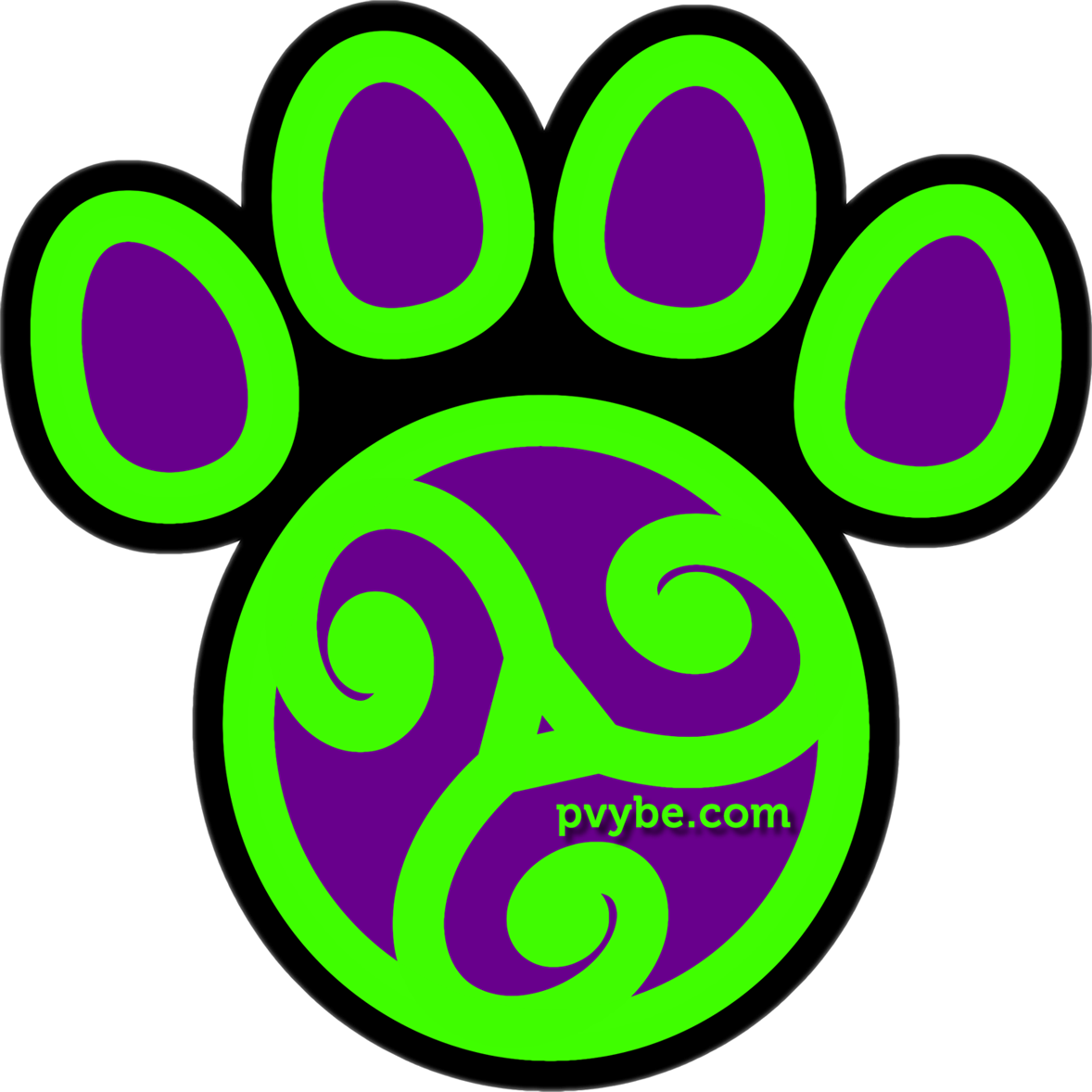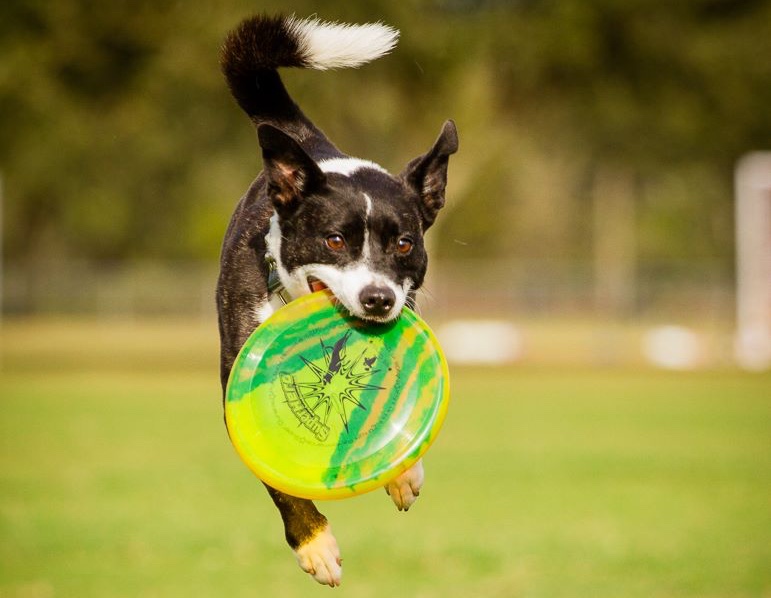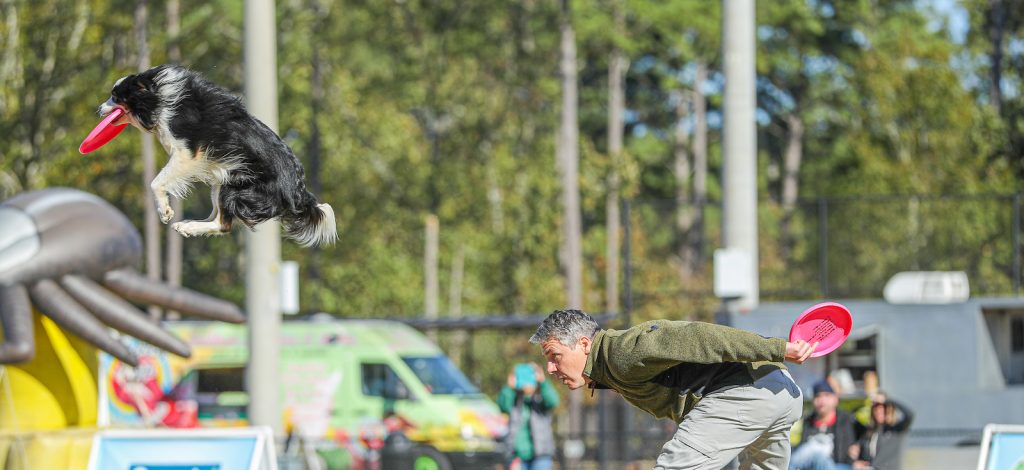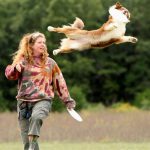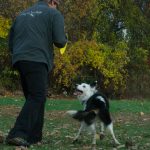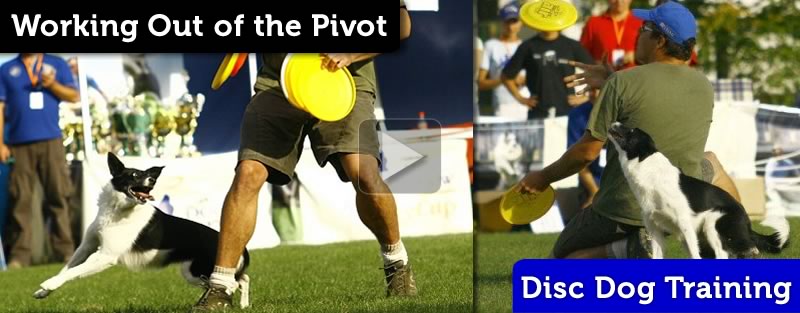
Working Out of the Pivot
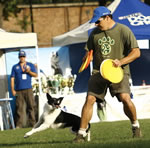 The Pivot happens when the dog changes direction enough to cause some kind of reversal of field, essentially a 90 degree angle or more. There is a moment half way between changing directions, a moment when the dog is almost “stationary”. That moment of balance, is the Pivot.
The Pivot happens when the dog changes direction enough to cause some kind of reversal of field, essentially a 90 degree angle or more. There is a moment half way between changing directions, a moment when the dog is almost “stationary”. That moment of balance, is the Pivot.
A Pivot combined with consistent position can create a set up move Set Up Moves are tricks that are used to establish timing and position in disc dog freestyle. Traditional tricks include: Around, Through, Backwards Through, and Scoot, but any or all of your tricks,... More that can be harnessed to create fresh and interesting sequences and tricks. A Pivot provides a consistent “stationary” position that allows a handler to generalize a maneuver to an alternate distance and positional relationship between the dog and handler.
Set Up Moves are tricks that are used to establish timing and position in disc dog freestyle. Traditional tricks include: Around, Through, Backwards Through, and Scoot, but any or all of your tricks,... More that can be harnessed to create fresh and interesting sequences and tricks. A Pivot provides a consistent “stationary” position that allows a handler to generalize a maneuver to an alternate distance and positional relationship between the dog and handler.
Major Pivots:
- Here – Front Cross
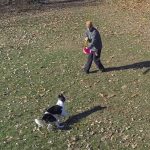 On a Front Cross, your dog switches Flanks in with you in front of them. From Clock to Counter Clockwise Flank or vice versa. Taken directly from the canine agility world, the Front... More
On a Front Cross, your dog switches Flanks in with you in front of them. From Clock to Counter Clockwise Flank or vice versa. Taken directly from the canine agility world, the Front... More - Squib – Rear Cross
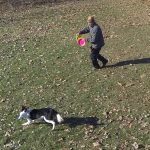 On a Rear Cross, the dog switches Flanks with the behind her. From clock to counter clockwise Flank or vice versa. Taken directly from the canine agility world, the Rear Cross is a... More
On a Rear Cross, the dog switches Flanks with the behind her. From clock to counter clockwise Flank or vice versa. Taken directly from the canine agility world, the Rear Cross is a... More - Around
- Through
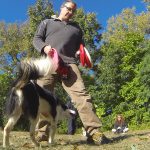 A Through is a set up move where the dog runs between the handler’s legs. The dog can move from front to back or side to side and can even weave. A Through... More – dog must reverse field like an around
A Through is a set up move where the dog runs between the handler’s legs. The dog can move from front to back or side to side and can even weave. A Through... More – dog must reverse field like an around - Recall – the snapping back to the handler
- Backwards Through
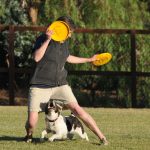 If your dog moves through your legs from back to front, that is a backwards Through. The Backwards Through usually sets up in one of two ways depending on where your dog’s starting... More – (1/2 an around and through back to front)
If your dog moves through your legs from back to front, that is a backwards Through. The Backwards Through usually sets up in one of two ways depending on where your dog’s starting... More – (1/2 an around and through back to front) - Flip – landing of flip is balance
- Reverse
- Scoot
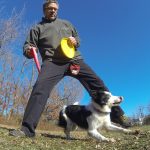 A Scoot is a Set Up Move where the dog scoots backwards between the handler’s legs. It’s a really clever Set Up Move, the image of your dog spinning around and shimmying backwards... More
A Scoot is a Set Up Move where the dog scoots backwards between the handler’s legs. It’s a really clever Set Up Move, the image of your dog spinning around and shimmying backwards... More
Understand Position and Placement
In order to use the pivot to your advantage the dog and handler have to have a good understanding of position and placement of the disc. You must be able to predict the dog’s movement and place a disc where it needs to be for the follow up trick, whether it be a vault, flip or big leaping catch. This is not an easy task because the pivot may or may not be in a frontal or standard position. Figuring out how to deliver a disc with the proper angle is not a simple task once the angles get unfamiliar, finding out when the disc needs to be there for a flip at 8 yards is no picnic either.
Flipping the Pivot
Reading our dog and understanding the properties of his movement and athletic capabilities, strengths and weaknesses, are a key element of flipping on the Pivot. Without this understanding and the ability to deliver the disc reliably with precision, flipping on the Pivot is a dangerous activity flipping should remain a stationary skill.
If the dog is well balanced in the pivot the trick will come off well. If the dog is unbalanced in the pivot you will get wild erratic trajectories and flailing.
Whether or not the dog is well balanced or not is entirely dependent upon the handler’s approach to establishing the pivot and delivering out of it. It is the handler’s responsibility to fully understand the time, place and position of the pivot, and to serve a disc at a particular time, place and orientation that creates a safe and successful flip. The dog can easily overcommit while working out of the pivot.
Flipping the pivot often happens during the part of the game where the dog is working in close, but rarely happens on the flat or during/out of set up moves. That’s where the freshest benefits will come from for most players.
Leaping off the Pivot
Setting a clean, aggressive starting point, with a pivot is great for setting a dog’s stride for a big catch on the run. The first several strides after the pivot happens will be standard. The handler can then choose the distance required to hit the dog on the run in stride and at the apex of his leap.
Moving from a position of balance with immediate commitment creates the right tone and timing for a Big Leaping catch. You can see this in well dialed in teams’ Go AroundAn Around, or a Go Around is the traditional disc dog set up move. The dog goes around the handler’s body in a clockwise or counter clockwise fashion allowing dog and handler to... More and through work. The set up move, in particular, the Pivot sets the tone and timing for good leaping.
The same kind of hook up between dog and handler is available to us through any of the other pivots, although planned, big leaping is rarely seen out of the other pivot moves like the rear cross or a flip. Look for pivots that make for interesting angles for big leaping.
Reward Placement and the Pivot
Dogs gravitate to where the Reward happens. If you have a history of throwing a big, Mighty Zig Zag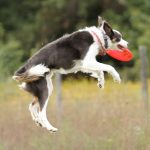 A Zig Zag is a series of catches in smooth succession that forces the dog to move back and forth across the field. Usually performed at a distance of 8-20 yards, the Zig... More, 20+ yards, the pivot on a reversal of field is going to be extremely aggressive, as the dog will be shifting direction and moving with serious intent to where the target normally is. If you throw a flip to a dog that is used to releasing like that, you could have serious trouble.
A Zig Zag is a series of catches in smooth succession that forces the dog to move back and forth across the field. Usually performed at a distance of 8-20 yards, the Zig... More, 20+ yards, the pivot on a reversal of field is going to be extremely aggressive, as the dog will be shifting direction and moving with serious intent to where the target normally is. If you throw a flip to a dog that is used to releasing like that, you could have serious trouble.
Throwing a bit behind the dog (making them slow down – 10 yards instead of 20+ on the Mighty Zig Zag) or breaking things down and shaping the pivot with a good solid wait and clear intent (Art of Linking Tricks) will help you control your dogs commitment after the pivot. Too strong, or aggressive, a pivot, and the dog may not be able to accomplish the skill the handler is looking for.
Too weak and slow, and the dog cannot depend on fluid motion out of the pivot to set his stride and get the most out of this dynamic position.
